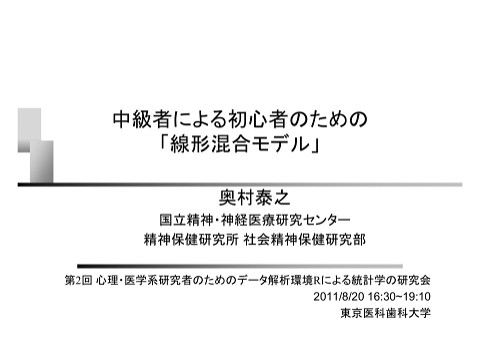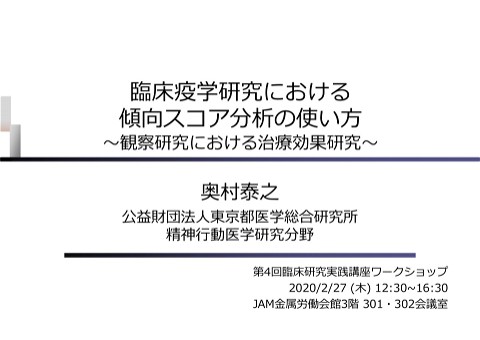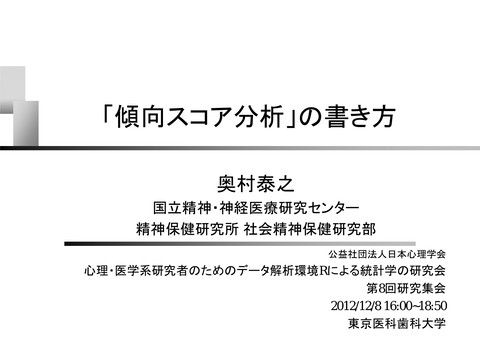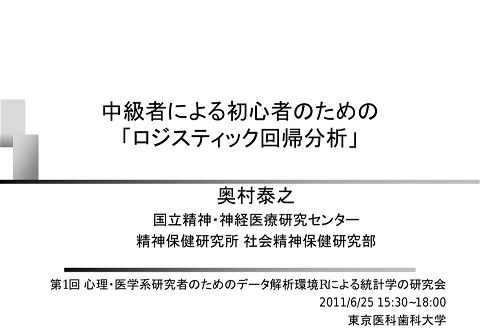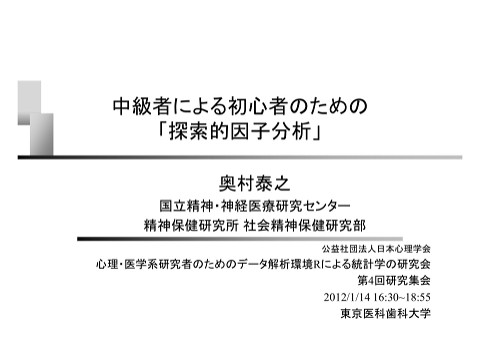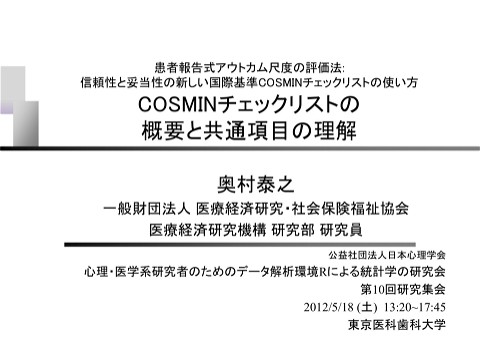明日から読めるメタ・アナリシス: ⾏動療法研究に求められる統計学
21.3K Views
May 24, 22
スライド概要
関連スライド
各ページのテキスト
料 抜 粋 明日から読めるメタ・アナリシス: ⾏動療法研究に求められる統計学 奥村泰之 資 一般財団法人 医療経済研究・社会保険福祉協会 医療経済研究機構 研究部 研究員 日本認知・⾏動療法学会第40回大会 2014/11/1 (土) 13:30~16:30 富山国際会議場 特別会議室
ファシリテーター 資 料 抜 粋 兼子唯 (早稲田大学) 横光健吾 (たばこ総合研究センター) 国⾥愛彦 (専修大学) 土屋政雄 (労働安全衛生総合研究所) ⽵林由武 (統計数理研究所) 土井理美 (北海道医療大学) 馬ノ段梨乃 (京都産業メンタルヘルスセンター) 2
研修会の狙い 到達目標 料 抜 個別目標 粋 無作為化比較試験のメタ・アナリシスを読む 能⼒を養う 1. 無作為化比較試験の要点を理解できる 資 2. メタ・アナリシスの批判的吟味の要点を理解 できる 3. 無作為化比較試験のメタ・アナリシスを検 索・⼊⼿できる 3
RCTの3類型と研究疑問の定式化 バイアスへのリスクの評価 アウトカムの評価指標 (質的変数) アウトカムの評価指標 (量的変数) 資 料 抜 粋 無作為化比較試験の要点の理解 4
無作為化比較試験 (RCT) の型 料 抜 資 未来 アウトカム測定 無作為化 症例登録 実験群 対照群 粋 現在 5
3種類のRCT,実験的介⼊の優越性 「優れている」 と判断する限界値 資 料 抜 粋 優越性試験 E is better Lesaffre E: Bull NYU Hosp Jt Dis. 2008;66(2):150-4. 0 C is better 6
3種類のRCT,実験的介⼊の非劣性 「劣っていない」 と判断する限界値 資 料 抜 粋 非劣性試験 E is better Lesaffre E: Bull NYU Hosp Jt Dis. 2008;66(2):150-4. 0 C is better 7
3種類のRCT,実験的介⼊の同等性 「同等である」 と判断する限界値 資 料 抜 粋 同等性試験 E is better Lesaffre E: Bull NYU Hosp Jt Dis. 2008;66(2):150-4. 0 C is better 8
研究疑問の定式化 (PICO-T) 資 料 抜 粋 Patients...患者 Intervention...介⼊ Comparison...比較対照 Outcome...アウトカム Time...時間 中川敦夫: 臨床研究の歴史、意義、研究の定式化 (2012年度版). (http://www.icrweb.jp/) 9
研究疑問の定式化の事例 インターネット⽀援型認知⾏動療法を受けた人は, 粋 I : C : 12~18歳の慢性疲労症候群の患者を対象に, 料 抜 P : 通常の理学療法⼠による介⼊を受けた人と比べて, 過去12日間における授業の完全出席率が高いか T : 治療開始6か月時点 資 O : Nijhof SL et al: Lancet. 2012 Apr 14;379(9824):1412-8. 10
RCTの3類型と研究疑問の定式化 バイアスへのリスクの評価 アウトカムの評価指標 (質的変数) アウトカムの評価指標 (量的変数) 資 料 抜 粋 無作為化比較試験の要点の理解 14
バイアス (真実からの乖離) へのリスク 資 料 抜 粋 バイアスの種類 判断基準 選択バイアス 乱数生成 割り付けの隠蔽化 実⾏バイアス 患者と治療者の盲検化 検出バイアス 評価者の盲検化 欠測バイアス アウトカム測定の完全性 報告バイアス 事前設定したアウトカム報告 Chapter 8: Assessing risk of bias in included studies (http://www.cochrane.org/handbook) 15
0.89 (0.82,0.96) 料 抜 乱乱乱乱 : 不不不 /不不 (832試試 ) vs. 不不 (112試試 ) 粋 選択バイアスによる過大評価,乱数生成 の不備11%,割り付けの隠蔽化の不備7% 資 隠隠隠 : 不不不 /不不 (916試試 ) vs. 不不 (376試試 ) 0.93 (0.87,0.99) 0.8 0.9 1.0 1.1 1.2 Ratio of Odds Ratio Savović J et al: Ann Intern Med. 2012 Sep 18;157(6):429-38. 16
資 料 抜 粋 バイアスへのリスクの評価法 Chapter 8: Assessing risk of bias in included studies (http://www.cochrane.org/handbook) 17
乱数生成の評価基準例 ‘High risk’ of bias 料 抜 ‘Low risk’ of bias 粋 介⼊の利⽤可能性により割り付け (allocated by availability of the intervention) 患者の好みにより割り付け (allocation by preference of the participants) コンピュータによる乱数生成 (using a computer random number generator) 最小化法の使⽤ (using minimization methods) 資 ‘Unclear risk’ of bias 無作為に割り付け (patients were randomly allocated) Chapter 8: Assessing risk of bias in included studies (http://www.cochrane.org/handbook) 18
割り付けの隠蔽化の評価基準例 ‘High risk’ of bias 料 抜 粋 封印されていない封筒の利⽤ (assignment envelopes were used without appropriate safeguards) 公開された割り付け予定乱数の利⽤ (using an open random allocation schedule) ‘Low risk’ of bias 資 中央登録⽅式の利⽤ (using a method of central allocation) 不透明の封印された連続番号の封筒の利⽤ (using a method of sequentially numbered, opaque, sealed envelopes) ‘Unclear risk’ of bias 無作為に割り付け (patients were randomly allocated) Chapter 8: Assessing risk of bias in included studies (http://www.cochrane.org/handbook) 19
治療者と患者の盲検化の評価基準例 ‘High risk’ of bias 料 抜 ‘Low risk’ of bias 粋 治療者と患者の盲検化を試みたが,失敗している可能性がある (blinding of key study participants and personnel attempted, but likely that the blinding could have been broken) 治療者と患者の盲検化は確実である (blinding of participants and key study personnel ensured) 資 ‘Unclear risk’ of bias 判断するための十分な記載がない Chapter 8: Assessing risk of bias in included studies (http://www.cochrane.org/handbook) 20
評価者の盲検化の評価基準例 ‘High risk’ of bias 料 抜 ‘Low risk’ of bias 粋 評価者の盲検化を⾏っておらず,盲検化の有無が測定結果に影響する可能 性がある (no blinding of outcome assessment, and the outcome measurement is likely to be influenced by lack of blinding) 評価者の盲検化を確かに⾏っている (blinding of outcome assessment ensured, and unlikely that the blinding could have been broken) 資 ‘Unclear risk’ of bias 判断するための十分な記載がない Chapter 8: Assessing risk of bias in included studies (http://www.cochrane.org/handbook) 21
アウトカム測定の完全性の評価基準例 ‘High risk’ of bias 料 抜 粋 欠測の理由が,真のアウトカムの値と関連する (reason for missing outcome data likely to be related to true outcome) 不適切な単一代⼊法を利⽤する (potentially inappropriate application of simple imputation) ‘Low risk’ of bias アウトカム測定に欠測がない (no missing outcome data) 資 ‘Unclear risk’ of bias 判断するための十分な記載がない Chapter 8: Assessing risk of bias in included studies (http://www.cochrane.org/handbook) 22
事前設定したアウトカム報告の評価基準例 ‘High risk’ of bias ‘Low risk’ of bias 粋 一つ以上の主要評価項目が事前に設定されていない (one or more reported primary outcomes were not pre-specified) 料 抜 研究計画書が⼊⼿可能であり,すべての評価項目は事前設定と一致してい る (the study protocol is available and all of the pre-specified (primary and secondary) have been reported in the pre-specified way) 資 ‘Unclear risk’ of bias 判断するための十分な記載がない Chapter 8: Assessing risk of bias in included studies (http://www.cochrane.org/handbook) 23
RCTの3類型と研究疑問の定式化 バイアスへのリスクの評価 アウトカムの評価指標 (質的変数) アウトカムの評価指標 (量的変数) 資 料 抜 粋 無作為化比較試験の要点の理解 25
アウトカムの評価指標 アウトカムの種類 質的 (2水準) 粋 要素 量的 平均値 標準偏差 群間差の評価指標 リスク比 オッズ比 リスク差 必要治療症例数 (NNT) 平均値差 標準化平均値差 資 料 抜 群ごとの評価指標 イベント発生率 (リスク) Higgins JPT, Green S: Cochrance handbook for systematic reviews of interventions. Wiley-Blackwell. 2008 26
アウトカム,質的変数の事例 12~18歳の慢性疲労症候群におけるインターネッ ト⽀援型認知⾏動療法による授業出席への効果 粋 アウトカム: 6か月時点の過去12日間における授業の完全出 席の有無 (欠席率10%以下) 資 要素 インターネット支援 型認知⾏動療法 通常診療 料 抜 介⼊と対照: 認知⾏動療法群 67名 vs. 通常診療群 64名 あり 授業の完全出席 なし 50 (75%) 17 (25%) 10 (16%) 54 (84%) Nijhof SL et al: Lancet. 2012 Apr 14;379(9824):1412-8. 27
群ごとの評価指標,イベント発生率 オッズ (odds) イベント発生数 標本サイズ イベント発生数 イベント未発生数 粋 計算式 リスク (risk) 料 抜 統計量 0〜1 事例 50/67 = 0.75 50/17 = 2.94 解釈 100人中75名が授業 完全出席 授業の完全出席3名に つき不完全出席1名 資 得点範囲 0〜∞ 28
群間の評価指標,リスク比 統計量 実験群のイベント発生率 RR = 対照群のイベント発生率 料 抜 粋 計算式 リスク比 (Risk ratio/Relative risk: RR) 得点範囲 0〜1〜∞ (1=「群間差なし」) <1: 実験群のイベント発生率は,対照群のRR =1: 両群で差がない >1: 実験群のイベント発生率は,対照群のRR倍 解釈② 介⼊によりイベント発生率が100×(RR-1)%増加 介⼊によりイベント発生率が100×(1-RR)%減少 資 解釈① 29
リスク比の計算と解釈例 完全出席のリスク RR (50/67)/(10/64) = 0.75/0.16 (17/67)/(54/64) = 0.25/0.84 = 4.78 = 0.30 授業の不完全出席率は,認知 ⾏動療法群は,通常診療群の 3/10であった (0.84*0.30=0.25) 料 抜 解釈① 授業の完全出席率は,認知 ⾏動療法群の⽅が,通常診 療群よりも4.78倍高かった (0.16*4.78=0.75) 不完全出席のリスク 粋 事例 資 解釈② 認知⾏動療法により,授業 認知⾏動療法により,授業の 完全出席率が378%増加 不完全出席率が70%減少 (0.84-0.84*0.70=0.25) (0.16*3.78+0.16=0.75) 対称性 1/RR = 1/4.78 ≠ 0.30 1/RR = 1/0.30 ≠ 4.78 30
群間の評価指標,オッズ比 統計量 実験群のオッズ OR = 対照群のオッズ 料 抜 粋 計算式 オッズ比 (Odds Ratio: OR) 得点範囲 0〜1〜∞ (1=「群間差なし」) <1: 実験群のイベント発生オッズは,対照群のOR =1: 両群で差がない >1: 実験群のイベント発生オッズは,対照群のOR倍 解釈② 介⼊によりイベント発生オッズが100×(OR-1)%増加 介⼊によりイベント発生オッズが100×(1-OR)%減少 資 解釈① 31
オッズ比の計算と解釈例 完全出席のオッズ 不完全出席のオッズ OR (50/17)/(10/54) = 2.94/0.19 = 15.88 (17/50)/(54/10) = 0.34/5.40 =0.06 粋 事例 料 抜 解釈① 授業の完全出席のオッズは, 授業の不完全出席のオッズは, 認知⾏動療法群の⽅が,通 認知⾏動療法群は,通常診療 群の6/100であった 常診療群よりも15.88倍高 かった (0.19*15.88=2.94) (5.40*0.06=0.34) 認知⾏動療法により,授業の 不完全出席のオッズが94%減 少 (5.54-5.54*0.94=0.34) 対称性 1/OR = 1/15.88 = 0.06 1/OR = 1/0.06 = 15.88 資 解釈② 認知⾏動療法により,授業 完全出席のオッズが1488% 増加 (0.19*14.88+0.19=2.94) 32
群間の評価指標,リスク差 統計量 計算式 リスク差 (Risk Difference: RD) RD = 実験群のイベント発生 率 − 粋 対照群のイベント発生 率 料 抜 得点範囲 -1〜0〜+1 (各群の発生率に依存) <0: 実験群のリスクは,対照群よりRD*100%低い =0: 両群で差がない >0: 実験群のリスクは,対照群よりRD*100%高い 解釈② 特定期間に1人多くイベント発生/発生防止することを 期待するには,比較対照の介⼊よりも実験的介⼊によ りNNT=[1/|RD|]人を治療する必要がある 資 解釈① 33
リスク差の計算と解釈例 完全出席のリスク 不完全出席のリスク RD (50/67)-(10/64) = 0.75- 0.16 = 0.59 (17/67)-(54/64) = 0.25-0.84 = -0.59 粋 事例 授業の不完全出席のオッズは, 認知⾏動療法群は,通常診療 群よりもの59%低かった (-0.59*100=-59) 解釈② 認知⾏動療法により1.7人治 療して (1/|0.59|=1.7),6か 月後に1人多く完全出席さ せられる 認知⾏動療法により1.7人治療 して (1/|-0.59|=1.7),6か月後 に1人多く不完全出席を防止で きる 資 料 抜 解釈① 授業の完全出席率は,認知 ⾏動療法群の⽅が,通常診 療群よりも59%高かった (0.59*100=59) 34
リスク比,オッズ比,リスク差の違い 数学的性質 解釈可能性 × ○ ◎ × × ◎ 粋 一貫性 ○ ○ × 料 抜 指標 リスク比 オッズ比 リスク差 資 推奨1.イベント定義に注意してリスク比/オッズ比 推奨2.評価指標により結論が変化しないか感度分析 Higgins JPT, Green S: Cochrance handbook for systematic reviews of interventions. Wiley-Blackwell. 2008 35
信頼区間の定義と解釈 定義 粋 ⺟数が存在していると思われる区間 料 抜 95%信頼区間 (95% Confidence Interval) 資 ⺟集団から無作為抽出をして,⺟数に関する 95%信頼区間を求める研究を無限回⾏ったとし たら,その複数の信頼区間のうち95%は⺟数を 含む範囲 信頼区間の幅 標本サイズが増えると幅が狭くなり精度が向上 36
信頼区間のイメージ (N = 131) 粋 料 抜 6 資 4 2 ににに比 8 10 母母母ににににににに比 = 4.7 0 20 40 60 80 100 繰り返し 37
信頼区間のイメージ (N = 786) 粋 料 抜 6 資 4 2 ににに比 8 10 母母母ににににににに比 = 4.7 0 20 40 60 80 100 繰り返し 38
RCTの3類型と研究疑問の定式化 バイアスへのリスクの評価 アウトカムの評価指標 (質的変数) アウトカムの評価指標 (量的変数) 資 料 抜 粋 無作為化比較試験の要点の理解 39
アウトカム,量的変数の事例 12~18歳の慢性疲労症候群におけるインターネッ ト⽀援型認知⾏動療法による慢性疲労への効果 粋 アウトカム: 6か月時点の慢性疲労の質問紙 (Checklist Individual Strength-20) の重症度 資 アウトカム 料 抜 介⼊と対照: 認知⾏動療法群 67名 vs. 通常診療群 64名 インターネット支 援型認知⾏動療法 疲労の重症度 (8~56点), 24.0 (13.4) 平均値 (標準偏差) Nijhof SL et al: Lancet. 2012 Apr 14;379(9824):1412-8. 通常診療 42.3 (13.1) 40
群間の評価指標,平均値差 計算式 平均値差 (Mean Difference: MD) MD = 実験群の平均値 − 対照群の平均値 粋 統計量 得点範囲 尺度の得点可能範囲に依存 料 抜 <0: 実験群のアウトカムの平均値は,対照群よりMD低い =0: 両群で差がない >0: 実験群のアウトカムの平均値は,対照群よりMD高い 資 解釈 41
群間の評価指標,標準化平均値差 SMD = sd pool = 3 実験群の平均値 − 対照群の平均値 1 − 4N − 9 sd pool 粋 計算式 標準化平均値差 (Standardized Mean Difference: SMD) 2 2 (n実験群 − 1)sd実験群 + (n対照群 − 1)sd 対照群 N −2 得点範囲 ー∞〜0〜+∞ 料 抜 統計量 <0: 実験群の評価項目の平均値は,対照群よりSMD*sdpool低い =0: 両群で差がない >0: 実験群の評価項目の平均値は,対照群よりSMD*sdpool高い 解釈② (慣例) =0.2: 小さな差 =0.5: 中程度の差 =0.8: 大きな差 資 解釈① 42
料 抜 Hedges’ g Cohen’s d Effect size 粋 標準化平均値差の別称 資 注) 研究者によって呼称 (+式) に混乱がみられる。 コクラン共同計画が採⽤する標準化平均値差の定 義式は,Hedgesの不偏推定量である。 43
平均値差と標準化平均値差の計算と解釈例 標準化平均値差 計算 MD = 24.0-42.3 = -18.3 SMD = -18.3/13.3*1 = -1.4 sdpool = 13.3 料 抜 粋 事例 平均値差 資 解釈 認知⾏動療法群の慢性疲 労の重症度の平均値は, 通常診療群より18.3点低 い 認知⾏動療法群の慢性疲労の重 症度の平均値は,通常診療群よ り1.4標準偏差 (18.3=1.4*13.3) 低い 44
平均値差と標準化平均値差の違い 料 抜 平均値差 標準化平均値差 尺度不変 解釈可能性 研究間の測定の 研究間の 信頼性の相違 集団の相違 × ○ ○ × ○ × × × 粋 指標 資 推奨1.研究間で同一の尺度であれば平均値差 推奨2.研究間で異なる尺度であれば標準化平均値差 Higgins JPT, Green S: Cochrance handbook for systematic reviews of interventions. Wiley-Blackwell. 2008 45
特徴 構造化抄録の理解 ⽅法の評価基準 結果の評価基準 資 料 抜 粋 メタ・アナリシスの要点の理解 46
全体像 系統的展望 Systematic Review 料 抜 2. 適格基準の定義 資 3. 異質性の事前仮説 4. 研究計画の公開 メタ・アナリシス Meta-analysis Murad MH et al: JAMA. 2014 Jul;312(2):171-9 Liberati A et al: PLoS Med. 2009 Jul 21;6(7):e1000100 6. 標題と要旨の選別 粋 1. 研究疑問の定式化 5. 文献検索 7. 適格基準の評価 8. バイアスの評価 9. データの抽出 10. データの統合 47
臨床家に系統的展望 (+ メタ・アナリシス) が 必要な理由 資 料 抜 粋 個々のRCTは,代表性が低い 複数のRCTを収集・評価する時間がない 個々のRCTより標本サイズが大きいため,研 究成果を患者に当てはめる自信が増す 個々のRCTの結果のバラツキの理由がわかる Murad MH et al: JAMA. 2014 Jul;312(2):171-9 48
基本形と派生モデル 分析単位 比較 (通常の) メタ・アナリシス 個別患者データの メタ・アナリシス ネットワーク・ メタ・アナリシス 研究 2群 患者 2群 研究 多群 資 料 抜 粋 特徴 49
事例,メタ・アナリシス,うつ病へのコンピ ュータCBT,⻑期予後の効果は認められず 治療後 資 料 抜 粋 ⻑期予後 So M et al: BMC Psychiatry. 2013 Apr 15;13:113 50
料 抜 資 治療後の重症度 粋 事例,個別患者データ,うつ病への低強度 介⼊,介⼊前の重症度が高いほど有効 介⼊前の重症度 Bower P et al: BMJ. 2013 Feb 26;346:f540. 51
事例,ネットワーク,うつ病への⼼理療法, 7つの技法間の差は小さい (SMD: 0.01~0.30) PST 料 抜 -0.10 -0.01 -0.12 -0.16 -0.18 -0.30 SST CBT BA 粋 DYN 0.09 -0.02 -0.06 -0.08 -0.19 資 SUP DYN SST PST CBT BA IPT SUP -0.11 -0.15 -0.17 -0.29 -0.04 -0.06 -0.18 -0.02 -0.14 -0.12 SUP = ⽀持的精神療法,DYN =⼒動的精神療法; SST = 生活技能訓練; PST = 問題解決療法; CBT = 認知⾏動療法; BA = ⾏動活性化法; IPT = 対人関係療法 Barth J: PLoS Med. 2013;10(5):e1001454. 52
特徴 構造化抄録の理解 ⽅法の評価基準 結果の評価基準 資 料 抜 粋 メタ・アナリシスの要点の理解 53
⼿始め,標題 資 料 抜 粋 系統的展望/メタ・アナリシス/両⽅ Liberati A et al: PLoS Med. 2009 Jul 21;6(7):e1000100 Fjorback LO et al: Acta Psychiatr Scand. 2011 Aug;124(2):102-19 Strauss C et al: PLoS One. 2014 Apr 24;9(4):e96110 Goyal M et al: JAMA Intern Med. 2014 Mar;174(3):357-68 54
⼿始め,要旨,背景 資 料 抜 粋 A previous Cochrane review (James 2005) showed that cognitive behavioural therapy (CBT) was effective in treating childhood anxiety disorders; however, questions remain regarding (1) the relative efficacy of CBT versus non-CBT active treatments; (2) the relative efficacy of CBT versus medication and the combination of CBT and medication versus placebo; and (3) the long-term effects of CBT. James AC et al: Cochrane Database Syst Rev. 2013 Jun 3;6:CD004690 55
⼿始め,要旨,目的 資 料 抜 粋 To examine (1) whether CBT is an effective treatment for childhood and adolescent anxiety disorders in comparison with (a) wait-list controls; (b) active non-CBT treatments (i.e. psychological placebo, bibliotherapy and treatment as usual (TAU)); and (c) medication and the combination of medication and CBT versus placebo; and (2) the long-term effects of CBT. James AC et al: Cochrane Database Syst Rev. 2013 Jun 3;6:CD004690 56
⼿始め,要旨,データ源と適格基準 データ源 適格基準 料 抜 粋 Searches for this review included the Cochrane Central Register of Controlled Trials (CENTRAL) and the Cochrane Depression, Anxiety and Neurosis Group Register, which consists of relevant randomised controlled trials from the bibliographic databases-The Cochrane Library (1970 to July 2012), EMBASE, (1970 to July 2012) MEDLINE (1970 to July 2012) and PsycINFO (1970 to July 2012). 資 All randomised controlled trials (RCTs) of CBT versus waiting list, active control conditions, TAU or medication were reviewed. All participants must have met the criteria of the Diagnostic and Statistical Manual (DSM) or the International Classification of Diseases (ICD) for an anxiety diagnosis, excluding simple phobia, obsessive-compulsive disorder, post-traumatic stress disorder and elective mutism. James AC et al: Cochrane Database Syst Rev. 2013 Jun 3;6:CD004690 57
⼿始め,要旨,研究評価と統合⽅法
資
料
抜
粋
The methodological quality of included trials was assessed by three
reviewers independently. For the dichotomous outcome of remission of
anxiety diagnosis, the odds ratio (OR) with 95% confidence interval (CI)
based on the random-effects model, with pooling of data via the inverse
variance method of weighting, was used. Significance was set at P < 0.05.
Continuous data on each child's anxiety symptoms were pooled using the
standardised mean difference (SMD).
James AC et al: Cochrane Database Syst Rev. 2013 Jun 3;6:CD004690
58
⼿始め,要旨,結果 ①ー(a) CBT vs Waiting list 資 料 抜 粋 Forty-one studies consisting of 1806 participants were included in the analyses. The studies involved children and adolescents with anxiety of mild to moderate severity in university and community clinics and school settings. For the primary outcome of remission of any anxiety diagnosis for CBT versus waiting list controls, intention-to-treat (ITT) analyses with 26 studies and 1350 participants showed an OR of 0.13 (95% CI 0.09 to 0.19, Z = 10.26, P < 0.0001), but with evidence of moderate heterogeneity (P = 0.04, I² = 33%). The number needed to treat (NNT) was 6.0 (95% CI 7.5 to 4.6). No difference in outcome was noted between individual, group and family/parental formats. James AC et al: Cochrane Database Syst Rev. 2013 Jun 3;6:CD004690 59
⼿始め,要旨,結果 ①ー(b) CBT vs active non-CBT 料 抜 (2) long-term effect 粋 ITT analyses revealed that CBT was no more effective than non-CBT active control treatments (six studies, 426 participants) or TAU in reducing anxiety diagnoses (two studies, 88 participants). 資 The few controlled follow-up studies (n = 4) indicate that treatment gains in the remission of anxiety diagnosis are not statistically significant. James AC et al: Cochrane Database Syst Rev. 2013 Jun 3;6:CD004690 60
⼿始め,要旨,結論 資 料 抜 粋 Cognitive behavioural therapy is an effective treatment for childhood and adolescent anxiety disorders; however, the evidence suggesting that CBT is more effective than active controls or TAU or medication at follow-up, is limited and inconclusive. James AC et al: Cochrane Database Syst Rev. 2013 Jun 3;6:CD004690 61
特徴 構造化抄録の理解 ⽅法の評価基準 結果の評価基準 資 料 抜 粋 メタ・アナリシスの要点の理解 63
メタ・アナリシス,⽅法の評価基準 資 料 抜 粋 研究疑問は理にかなっているか︖ 包括的に文献検索しているか︖ 研究選択と評価に再現性があるか︖ 解釈可能性のある評価指標を使ってるか︖ 統合した結果の信頼性を評価しているか︖ Murad MH et al: JAMA. 2014 Jul;312(2):171-9 64
研究疑問は理にかなっているか︖ 粋 料 抜 ① ② ③ ④ 介入 資 焦点化 アウト カム がん 治療 死亡 前⽴腺がん 化学療法 死亡 去勢抵抗性前⽴腺がん ドセタキセル 死亡 転移性去勢抵抗性 ドセタキセル 死亡 前⽴腺がん 疑問 患者 「患者」「介⼊」「アウトカム」の定義が研 究間で広がりのある中,その介⼊の効果が等 しいと思えるか︖ 65
事例,研究疑問の評価 P...19歳未満の全般性不安障害/社交不安障害/パ 粋 ニック障害 (PTSD/強迫性障害は除外) 資 DISCAP/CGI-I) 料 抜 I...認知⾏動療法 (集団療法や家族への介⼊も含む) O...不安障害の寛解 (ADIS-P/ADIS-C/ 疾病間に相違はないか︖ 集団認知⾏動療法を含めて良いか︖ 臨床全般印象改善度 (CGI-I) を含めて良いか︖ James AC et al: Cochrane Database Syst Rev. 2013 Jun 3;6:CD004690 66
包括的に文献検索しているか︖ 基準 料 抜 粋 ①文献データベースを複数利⽤ (例: MEDLINE/EMBASE/Cochrane Central Register of Controlled Trials) 資 ②追加検索を実施 (例: 臨床試験登録/引⽤文献/学会発表/専門家への聴取/ 製薬会社や規制当局データベースの検索) Murad MH et al: JAMA. 2014 Jul;312(2):171-9 67
事例,包括的文献検索の評価 文献データベースを複数利⽤ 料 抜 粋 We identified all studies that might describe RCTs of CBT for anxiety disorders in children and adolescents from the Depression, Anxiety and Neurosis Cochrane Review Group Trials Registers (CCDANCTR) (most recent search, 01/05/2012). ...(中略)... Reports of trials for inclusion in the Group’s registers are collated from routine (weekly), generic searches of MEDLINE (1950-), EMBASE (1974-) and PsycINFO (1967-), from quarterly searches of the Cochrane Central Register of Controlled Trials (CENTRAL) and from review-specific searches of additional databases. 資 追加検索を実施 The WHO Trials portal (ICTRP) and ClinicalTrials.gov were also searched to identify additional unpublished and/or ongoing studies. James AC et al: Cochrane Database Syst Rev. 2013 Jun 3;6:CD004690 68
研究選択と評価に再現性があるか︖ 基準 粋 ①2人以上でレビューし,恣意性の⼊る部分を独⽴評価 (例: 研究選択/バイアスへのリスクの評価/データの抽出) 資 料 抜 ②評定者一致の指標を報告 (例: κ係数) Murad MH et al: JAMA. 2014 Jul;312(2):171-9 69
事例,再現性の評価 独⽴評価 (研究選択) 資 料 抜 粋 All citations identified by searching were separately inspected by four reviewers (ACJ, FAC, GJ and AS) to ensure reliability. All articles that possibly met our inclusion criteria were obtained so that the full text could be independently assessed as to whether they met review criteria. Authors were not blinded to the names of authors, institutions, journals of publication and results, when they applied the inclusion criteria. Any disagreement on the eligibility of a study was discussed with the other review authors, and, where necessary, the authors of the studies were contacted for further information. 独⽴評価 (バイアスへのリスクの評価) For each included study, three review authors (ACJ, FAC and GJ) independently assessed risk of bias... (後略) James AC et al: Cochrane Database Syst Rev. 2013 Jun 3;6:CD004690 70
事例,再現性の評価 独⽴評価 (データの抽出) 料 抜 粋 Data extraction forms were developed a priori and included information regarding study methods, participant details, treatment details and adherence to treatment protocol and outcome measures. Data were extracted and assessed by FAC, GJ and ACJ independently. Consensus was reached through discussion. In cases of disagreement, the other review authors were consulted. 記載なし 資 評定者一致の指標 厳密な独⽴評価 評定者一致の指標はないが,合意形成で代替 James AC et al: Cochrane Database Syst Rev. 2013 Jun 3;6:CD004690 71
解釈可能性のある指標を使っているか︖ アウトカムの種類 質的 (2水準) 粋 要素 平均値差 標準化平均値差 資 料 抜 群間差の評価指標 リスク比 オッズ比 リスク差 必要治療症例数 (NNT) 量的 意思決定には,リスク差や平均値差が有⽤ Murad MH et al: JAMA. 2014 Jul;312(2):171-9 72
事例,解釈可能性の評価 必要治療症例数 (NNT) の利⽤ 資 料 抜 粋 The review used ORs and 95% CIs based on the random-effects model, with pooling of data via the inverse variance method of weighting. Significance was set at P < 0.05. Where available, data from an interview with the child or adolescent were used; otherwise data from interviews with the parents were used. Where both endpoint and change data were available for the same outcome, the endpoint was presented. The number needed to treat (NNT) with 95% CIs was calculated (STATA 2009). For each comparison, a summary statistic of all those responding to treatment was calculated as a percentage of the total number of participants. James AC et al: Cochrane Database Syst Rev. 2013 Jun 3;6:CD004690 73
統合した結果の信頼性を評価しているか︖ 粋 基準 ①バイアスへのリスクを評価 資 料 抜 ②研究間の異質性の評価 (例: コクランQ検定 [χ2検定]/I2統計量) Murad MH et al: JAMA. 2014 Jul;312(2):171-9 74
事例,統合した結果の信頼性の評価 バイアスへのリスクの評価 料 抜 粋 For each included study, three review authors (ACJ, FAC and GJ) independently assessed risk of bias using the seven domains set out below from the Cochrane Handbook for Systematic Reviews of Interventions (Higgins 2011), with ratings of ’low risk’, ’high risk’ and ’unclear risk’: (後略) 研究間の異質性の評価 資 The Chi2 test and the I2 statistic were used to assess statistical heterogeneity for all analyses and between groups. Significance was set at P < 0.1. The Cochrane Handbook for Systematic Reviews of Interventions (Higgins 2011) recommends using a range for I2 and a guide to interpretation. For this review, if either moderate heterogeneity (I2 in the range of 30% to 60%) or substantial heterogeneity (I2 in the range of 50% to 90%) was found, subgroup and sensitivity analyses were used, with meta-regression analyses (STATA 2009). James AC et al: Cochrane Database Syst Rev. 2013 Jun 3;6:CD004690 75
研究間の異質性の評価法 資 料 抜 粋 評価法 判断 コクランQ検定 小さいp値→異質性 I2統計量 0~40%→重要でない異質性 30~60%→中程度の異質性 50~90%→相当な異質性 75%~100%→重大な異質性 Higgins JPT, Green S: Cochrance handbook for systematic reviews of interventions. Wiley-Blackwell. 2008 76
特徴 構造化抄録の理解 ⽅法の評価基準 結果の評価基準 資 料 抜 粋 メタ・アナリシスの要点の理解 78
メタ・アナリシス,結果の評価基準 資 料 抜 粋 バイアスへのリスクは深刻か︖ 個々の研究結果は一貫しているか︖ 信頼区間は狭いか︖ 研究結果を自分の患者に使えるか︖ 報告バイアスの問題に注意しているか︖ Murad MH et al: JAMA. 2014 Jul;312(2):171-9 79
バイアスへのリスクは深刻か︖ 資 料 抜 粋 基準 ①個々の研究のバイアスへのリスクの評価 (例: 一覧表) ②研究全体のバイアスへのリスクの評価 (例: 感度分析として,バイアスへのリスクが高い研究を 除外) Murad MH et al: JAMA. 2014 Jul;312(2):171-9 80
事例,バイアスへのリスクの評価 資 料 抜 粋 個々の研究のバイアスへのリスクの 評価結果と判断根拠 James AC et al: Cochrane Database Syst Rev. 2013 Jun 3;6:CD004690 81
事例,バイアスへのリスクの評価 資 料 抜 粋 評価結果の集約 James AC et al: Cochrane Database Syst Rev. 2013 Jun 3;6:CD004690 82
事例,バイアスへのリスクの評価 研究全体のバイアスへのリスクの評価 資 料 抜 粋 (⽅法) Those studies judged to be at high risk of bias for selection bias were excluded from the main analysis. (結果) A sensitivity analysis (not shown) for those studies reporting clear processes of randomisation showed similar direction of results as the main analysis with all studies included, with CBT being effective versus W/L controls for the remission of anxiety diagnoses (OR 0.1, 95% CI 0.05 to 0.18, Z = 7.48, P < 0.00001). James AC et al: Cochrane Database Syst Rev. 2013 Jun 3;6:CD004690 83
個々の研究結果は一貫しているか︖ 資 料 抜 粋 基準 ①フォレストプロットの確認 (例: 点推定値の「差」と信頼区間の「重なり」) ②研究間の異質性の評価結果 (例: コクランQ検定/I2統計量) ③異質性の説明要因の検討 (例: サブグループ分析/メタ回帰分析) Murad MH et al: JAMA. 2014 Jul;312(2):171-9 84
事例,フォレストプロットの確認 資 料 抜 粋 26研究 (1350名) の 統合結果 (CBT vs Waiting List) James AC et al: Cochrane Database Syst Rev. 2013 Jun 3;6:CD004690 85
事例,フォレストプロットの確認 資 料 抜 粋 個々の研究の オッズ比と信頼区間 E is better James AC et al: Cochrane Database Syst Rev. 2013 Jun 3;6:CD004690 統合した オッズ比と信頼区間 C is better 86
料 抜 粋 事例,研究間の異質性の評価結果 資 異質性の評価結果 The standard mean difference (SMD) was 0.98 with significant heterogeneity E is better James AC et al: Cochrane Database Syst Rev. 2013 Jun 3;6:CD004690 C is better 87
事例,異質性の説明要因の検討 資 料 抜 粋 個人療法の結果 E is better James AC et al: Cochrane Database Syst Rev. 2013 Jun 3;6:CD004690 C is better 88
事例,異質性の説明要因の検討 資 料 抜 粋 集団療法の結果 E is better James AC et al: Cochrane Database Syst Rev. 2013 Jun 3;6:CD004690 C is better 89
事例,異質性の説明要因の検討 資 料 抜 粋 家族介⼊の結果 E is better James AC et al: Cochrane Database Syst Rev. 2013 Jun 3;6:CD004690 C is better 90
信頼できるサブグループ分析 料 抜 粋 サブグループ間の効果の相違の⽅向性につい て,最小限の仮説を事前に設定している サブグループ間の効果が異なる (交互作⽤) 交互作⽤は,メタ・アナリシス*ではなく , 個々の研究から⽀持される 資 *個別患者データのメタ・アナリシスは例外 結果は,生物学的説明と整合性がある 交互作⽤に再現性がある (先⾏研究) Sun X et al: JAMA. 2014 Jan 22-29;311(4):405-11. 91
信頼区間は狭いか︖ 料 抜 粋 基準 ①上側と下側の信頼限界の解釈の同等性の評価 (同等であればエビデンスは正確と評価) 資 本質的に,主観的判断を伴う Murad MH et al: JAMA. 2014 Jul;312(2):171-9 92
事例,信頼区間の狭さの評価 料 抜 粋 The number needed to treat (NNT) using conservative ITT data is 6.0 (95% CI 7.5 to 4.6), which means that for one additional participant to attain remission from anxiety disorder using CBT, one needs to treat six participants. In terms of medical and psychological treatments, this is an acceptable finding (Laupacis 1988), allowing one to recommend CBT in clinical practice. 資 5名 (NNT=4.6) と8名 (NNT = 7.5) は,実質的な 差がないと判断 James AC et al: Cochrane Database Syst Rev. 2013 Jun 3;6:CD004690 93
研究結果を自分の患者に使えるか︖ 資 料 抜 粋 基準 ①患者の同等性の評価 (例: 臨床は高齢者 vs. 研究は高齢者除外) ②介⼊の同等性の評価 (例: 臨床は実薬間の比較 vs. 研究は実薬とプラセボ比較) ③アウトカムの同等性の評価 (例: 臨床は⼼⾎管疾患イベント vs. 研究はHbA1c) 臨床と研究の差が大きいと,間接的なエビデン スとみなされる Murad MH et al: JAMA. 2014 Jul;312(2):171-9 94
報告バイアスの問題に注意しているか︖ 資 料 抜 粋 基準 ①出版バイアスの評価 (例: ファンネルプロット/Egger検定) ②未公表の研究の検索 (例: 臨床試験登録) 本質的な解決策は,統計⼿法ではなく,臨床試 験登録の義務化と網羅的検索 Murad MH et al: JAMA. 2014 Jul;312(2):171-9 95
事例,報告バイアスの評価 粋 料 抜 資 標準誤差 統合したオッズ比 (点線) を中⼼に, オッズ比が対照に分布していると出版 バイアスがないことを示唆 James AC et al: Cochrane Database Syst Rev. 2013 Jun 3;6:CD004690 オッズ比 96
資 検索 ⼊⼿ 料 抜 粋 メタ・アナリシスの検索と⼊⼿ 99
資 料 抜 粋 メタ・アナリシス,①学術論文,②コクラン ライブラリー,③ガイドラインに掲載 100
掲載先による特徴の違い コクランレビュー ガイドライン 研究の質 △ ○ △ 絶対数 ○ △ × 鮮度 ○ ○ × 無料⼊⼿ △ × ○ ○ × PubMed検索 料 抜 粋 学術論⽂ 資 特徴 △ 101
資 料 抜 粋 基本は,PubMed,MeSH検索 MeSH Databaseを クリック 102
MeSH⽤語,meta-analysis Search をクリック 資 料 抜 粋 meta-analysis と⼊⼒ 103
2⽤語ヒット 資 料 抜 粋 Meta-analysis[Publication Type] をクリック 104
粋 MeSH⽤語の定義 資 料 抜 Add to search builder をクリック 105
検索式の確認 資 料 抜 粋 “Meta-Analysis”[Publication Type] 検索式が生成 106
検索条件,「患者」と「介⼊」の追加 料 抜 粋 Patients...慢性疲労症候群 Intervention...⼼理療法 資 注) 患者や介⼊の検索条件は,広めに設定 107
MeSH⽤語,慢性疲労症候群 Search をクリック 資 料 抜 粋 chronic fatigue syndrome と⼊⼒ 108
粋 MeSH⽤語の定義 資 料 抜 Add to search builder をクリック 109
粋 検索式の確認 資 料 抜 "Fatigue Syndrome, Chronic"[Mesh] 検索式が追加 110
MeSH⽤語,⼼理療法 Search をクリック 資 料 抜 粋 psychotherapy と⼊⼒ 111
粋 10⽤語ヒット 資 料 抜 Psychotherapy をクリック 112
料 抜 粋 MeSH⽤語の定義 資 Add to search builder をクリック 113
MeSH⽤語の定義 料 抜 粋 "Psychotherapy"[Mesh] 検索式が追加 資 検索式がよければ Search PubMed をクリック 114
無料で読めるもの 資 料 抜 粋 5論文ヒット 115
資 検索 ⼊⼿ 料 抜 粋 メタ・アナリシスの検索と⼊⼿ 116
文献⼊⼿法 所属施設の図書館 文献複写依頼 料 抜 全文データベース 粋 購読雑誌 資 Google検索 国⽴国会図書館 著者請求 施設 個人 117
5論文の書誌情報 巻(号)頁 無料入⼿ 2013 PLoS One 8(8):e71834 ○ 2008 Cochrane Database Syst Rev (3):CD001027 × 2008 Clin Psychol Rev 28(5):736-45 × 2005 Psychosom Med 67(2):301-13 × 2001 Evid Rep Technol Assess (42):1-4 ○ 資 料 抜 粋 出版年 雑誌名 118
資 料 抜 粋 Google検索,”タイトル”+ filetype:pdf 119
国⽴国会図書館 資 料 抜 粋 インターネットから郵送複写サービス 120
Author Information にアドレス公開 資 料 抜 粋 著者請求,アドレス⼊⼿ 121
5論文の⼊⼿ 巻(号)頁 入⼿元 2013 PLoS One 8(8):e71834 無料 2008 Cochrane Database Syst Rev (3):CD001027 著者請求 2008 Clin Psychol Rev 28(5):736-45 国会図書館 2005 Psychosom Med 67(2):301-13 Google検索 2001 Evid Rep Technol Assess (42):1-4 無料 資 料 抜 粋 出版年 雑誌名 123
資 料 抜 粋 おわりに 124
ガイドラインにおけるエビデンスレベル RCT以外 粋 資 料 抜 RCT レベル エビデンスの種類 1++ 質の高いメタ・アナリシス,RCTの系統的 展望,バイアスのリスクが非常に小さい RCT 1+ 良くできたメタ・アナリシス, RCTの系統 的展望, バイアスのリスクが小さいRCT 1- メタ・アナリシス, RCTの系統的展望, バイ アスのリスクが大きいRCT 2++ バイアスのリスクが非常に小さい観察研究 の系統的展望 2+ バイアスのリスクが小さい観察研究 2- バイアスのリスクが大きい観察研究 3 症例シリーズ研究 4 専門家の意⾒ AHRQ: http://www.guideline.gov/content.aspx?id=39324 125
Take Home Messages 資 料 抜 粋 RCTのメタ・アナリシスの読解,臨床家に必須 研究疑問はPICO-Tに定式化 RCTの質の評価,コクラン,バイアスへのリスク 質的変数の評価,リスク比/リスク差/オッズ比 量的変数の評価,平均値差/標準化平均値差 メタ・アナリシスは,構造化抄録の理解から ⽅法と結果の評価は,JAMAユーザーズガイド PubMedで文献検索,文献⼊⼿は施設/個人 126
推薦図書 資 料 抜 粋 福原俊一: 臨床研究の道標: 7つのステップで学ぶ研究 デザイン. 健康医療評価研究機構. 2013. 福原俊一: リサーチ・クエスチョンの作り⽅.健康医 療評価研究機構. 2008 木原雅子, 木原正博:医学的研究のデザイン 研究の質 を高める疫学的アプローチ 第4版. メディカルサイエ ンスインターナショナル. 2014. 野⼝善令, 福原俊一:はじめてのメタアナリシス. 健康 医療評価研究機構. 2012 坂本 真⼠, 大平 英樹: ⼼理学論文道場: 基礎から始め る英語論文執筆. 世界思想社. 2013 127

